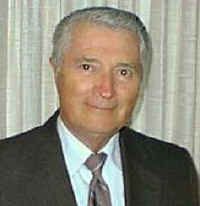|

George Herman Matter was born in Rochester, New York on June 13, 1920. He attended West High School with Warren Smith, where a physics teacher inspired both to go into optics. He had them do ray tracing of optics by placing two pins on a straight line (the input ray) and then view the pins through a prism or cylindrical lens. By placing two more pins in line with the image of the first two pins, the output ray was defined.
In 1940 George began his undergraduate studies in a pre-theology program at Hobart College. His studies were interrupted by World War II and George served three years in the Army Air Force. After discharge in 1946 he used the GI bill to attend the University of Rochester Institute of Optics. Prior to his acceptance at the university, George had a summer job with Bausch and Lomb. He also worked two summers for Eastman Kodak and joined Kodak as a full-time employee after graduation in 1949.
George's wife, Isabelle, got tuberculosis so they came out west in 1952 to cure it. He interviewed with Sandia Labs at Albuquerque, but was wanted very much by Northrop in Anaheim, Calif. He joined Northrop and remained there the rest of his career.
Some of the important people in his early career were his classmates from Rochester. George and Isabelle stayed with Al Lapinski, a former classmate at Los Alamos while George was interviewing with Sandia and Los Alamos. Al also came out west with George and Isabelle, and joined George at Northrop. Two other close friends and classmates were Henry Frels, who was the head of the optical group at Hughes Aircraft Company for a long time, and Howie Hoestery who later became VP of engineering of Ford Aeronutronics. George attributes much of his early success in zoom lens design to Northrop coworker Glen Wooters. Glenn and George were instrumental in obtaining David Grey's lens design optimization program for Northrop's use. George is most highly thought of by the "Northrop bunch", a group too numerous to list here, which includes two other OSSC Fellows and about ten past presidents.
George was Northrop's "guru" for the use of computers in lens design. That interest in computers started in the army where he was assigned to work in cryptography. Initially at Northrop he worked on the T-41 and T-46 stereo tank range finders, then the T-57 "coincidence" and "flicker" optical rangefinders. The earliest project in which he had an important design role was the Sky Screen. It combined a radar display with a situation board and required a zoom projection lens for magnification matching. Later under Dr. Konstantin Pestrecov and Bud Silvertooth he worked on a Stereo Comparison Viewer which used zoom lenses built by Taylor Hobson. These lenses lacked the high resolution required for aerial photography and it was decided that Northrop could design better lenses for this purpose using new lens optimization programs. Glen Wooters and Bud Silvertooth reasoned that a computer algorithm could be used to develop first-order zoom-lens solutions. Glenn developed such a program and this led to the development of several zoom lenses that George designed. His zoom lenses were unique in that they all were optically compensated. This reduced the number of moving parts in the lens to one! The largest zoom lens he designed was a 100-to-1 zoom lens for Boeing, which they put in a missile simulator at MICOM in Huntsville. He wishes that more of the projects he worked on, such as LATAR, IRST, TADS/PNVS, and Nessie, had gone into production. But before he retired in 1986, the Mast Mounted Sight did, and over 483 units have been produced so far, with 32 more on order!
George has been a member of OSSC since October, 1952. He attended at the request of his boss John Sonderman (a U of R Institute of Optics classmate of OSSC Fellow Al Shurkus), Chief Engineer at the Northrop Nortronics Anaheim plant. George was elected as a councilor in 1968, then vice president the very next year, and president in 1970-71. When he was VP and Don Nicholson was president of the board of directors, Matter persuaded many corporate members to take a larger role. His papers on zoom lenses and eyepieces contributed significantly to the optics literature.
George and Isabelle Matter live in Fullerton, California. They have one daughter, Mrs. Terry (Marie Matter) Stueland of Boulder City, Nevada. The Matters have two grandchildren, Trevor and Valerie. Valerie is attending ASU at Tempe, Arizona. George has organized a weekly round of golf at the Fullerton Golf Course and enjoys email from his friends.
|